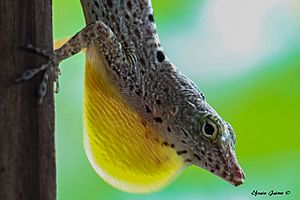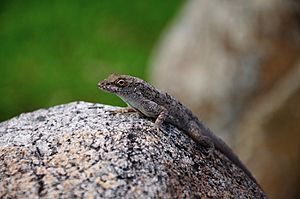Anolis stratulus facts for kids
Quick facts for kids Anolis stratulus |
|
|---|---|
 |
|
| Male with extended dewlap | |
| Scientific classification | |
| Genus: |
Anolis
|
| Species: |
stratulus
|
| Synonyms | |
|
|
The Anolis stratulus is a type of lizard called an anole. It's a medium-sized lizard found in Puerto Rico and the Virgin Islands. This anole is usually gray with brown spots.
You'll often find it living in trees, especially on the bark of branches high up. In some parts of Puerto Rico, there are huge numbers of these lizards. Tens of thousands can live in just one small area!
In Puerto Rico, people call it the lagartijo manchando, which means "spotted lizard." This name fits well because of the black spots on its back. Other English names for it include "spotted anole" and "Puerto Rican spotted anole." Some people also call it the "chameleon" because it can change its color.
Contents
Discovering the Spotted Anole
This lizard was first studied by a Danish pharmacist named Albert Heinrich Riise. He moved to St. Thomas Island in 1838. Riise was very interested in nature. He sent many plants and animals to museums in Europe and the United States.
Two zoologists in Copenhagen, Johannes Theodor Reinhardt and Christian Frederik Lütken, used Riise's collections. They were writing a big book about the reptiles of the Caribbean. They had named this lizard Anolis dorsomaculatus.
However, an American scientist named Edward Drinker Cope also studied Riise's specimens. Cope was very eager to describe new species. He published his work a week or two before Reinhardt and Lütken. This meant Cope's name for the lizard, Anolis stratulus, became the official one.
Cope first thought the lizard was only on St. Thomas. But Reinhardt and Lütken later corrected him. They showed it lived on other islands too. Cope also misspelled the lizard's name as striatulus, which was later fixed.
For a long time, the lizard's classification stayed the same. But in recent years, some scientists have debated if it should be in a different group. Today, most experts still agree it belongs in the Anolis group.
What's in a Name?
The name stratulus comes from a Latin word meaning "saddled." Cope chose this name because he thought the lizard had dark brown stripes across its back. He also thought it had a stripe on its tail.
However, later studies showed that these stripes are not always clear. Sometimes, the dark spots on its sides are more noticeable.
What Does it Look Like?
The Anolis stratulus is a small to medium-sized lizard. Adult males are about 40 to 44 millimeters (1.6 to 1.7 inches) long from snout to vent. Females are slightly larger, up to 46 millimeters (1.8 inches).
This lizard is usually gray or brownish-gray. It has light, hourglass-shaped spots from its neck to its tail. There's also a black, crescent-shaped mark behind its eye. Males often have clearer dark markings on their neck and back. Their sides have small dark spots.
The male has a large throat fan, called a dewlap. It's bright orange with light yellow scales. The tail is somewhat flat and has a toothed edge. It measures about 51 to 75 millimeters (2 to 3 inches) long.
Female dewlaps are much smaller and gray. They might have a little pale orange in the middle. Young lizards look just like the adults.
Similar Lizards
Young Anolis stratulus can sometimes look like young Anolis evermanni. However, Anolis evermanni juveniles have greenish-gray heads and necks, while Anolis stratulus juveniles are uniformly gray.
Scientists can also tell different anoles apart by looking at the patterns of scales on their heads.
Where Does it Live?
The Anolis stratulus lives in many places. It is found all over Puerto Rico and its nearby islands like Vieques and Culebra. You can see it in many forests there, like the Maricao State Forest and El Yunque National Forest. It's very common in the middle parts of Puerto Rico.
This lizard also lives in the British Virgin Islands. It has been seen on islands like Tortola and Virgin Gorda.
It's also very common in the northern United States Virgin Islands, especially on St. Thomas. It lives on many small islands and cays around St. Thomas. However, it is not found on the largest island, Saint Croix.
How it Lives
Its Home
This anole is a "trunk-crown ecomorph." This means it mostly lives on tree trunks and in the upper parts of trees (the canopy). You might also see it in tall grasses. It prefers to live high up in trees, usually from 2 meters (6.5 feet) up to the very top.
It can be found in both shady and sunny spots. It likes drier and moderately wet forests, not super wet ones. It lives from sea level up to about 365 meters (1,200 feet) high. Some have even been found higher, up to 945 meters (3,100 feet).
In El Yunque National Forest, these lizards live in the tall tabonuco trees, which are 10 to 20 meters (33 to 66 feet) tall. Even though there are many of them, they are hard to spot because they live so high up and blend in with the trees. After hurricanes, when many leaves and branches fall, you can see more of them. They then live among the fallen branches on the ground.
Daily Life
The Anolis stratulus lays eggs, which means it is oviparous. It can change its color to blend in. Its spots and markings help it hide on tree bark covered with lichen (a type of mossy growth).
These lizards usually stay in a small area, only moving about 6 meters (20 feet) to find food or a mate. They are active during the day, which means they are diurnal. They are not very shy, especially the males. They might even show their dewlap as a person gets close!
What it Eats
The Anolis stratulus's main food is ants. But it also eats other insects like beetles and flies. Sometimes, it eats land snails and spiders. It tends to eat more during the rainy season.
One time, a male lizard was seen drinking sweet nectar from the red flowers of a plant called Pedilanthus tithymaloides.
Lizard Health
In Puerto Rico, these lizards can sometimes get a type of lizard malaria. This is caused by a tiny parasite that infects their blood cells. It's spread by infected mosquitoes. Another anole species, A. gundlachi, gets this disease much more often than A. stratulus. Less than 1% of A. stratulus lizards are usually infected.
How Many Are There?
This is a very common lizard in many parts of Puerto Rico. There can be thousands, even tens of thousands, of them in just one acre of land. One study estimated about 21,500 per hectare (about 8,700 per acre).
The IUCN has not yet checked on the conservation status of this species. This means they haven't decided if it's endangered or not.
It lives in several protected areas, including:
- Guánica State Forest, Puerto Rico, USA.
- Reserva Forestal de Maricao, Puerto Rico, USA.
- Los Tres Picachos State Forest, Puerto Rico, USA.
- Virgin Islands National Park, U.S. Virgin Islands, USA.
- El Yunque National Forest, Puerto Rico, USA.
See Also
Images for kids




